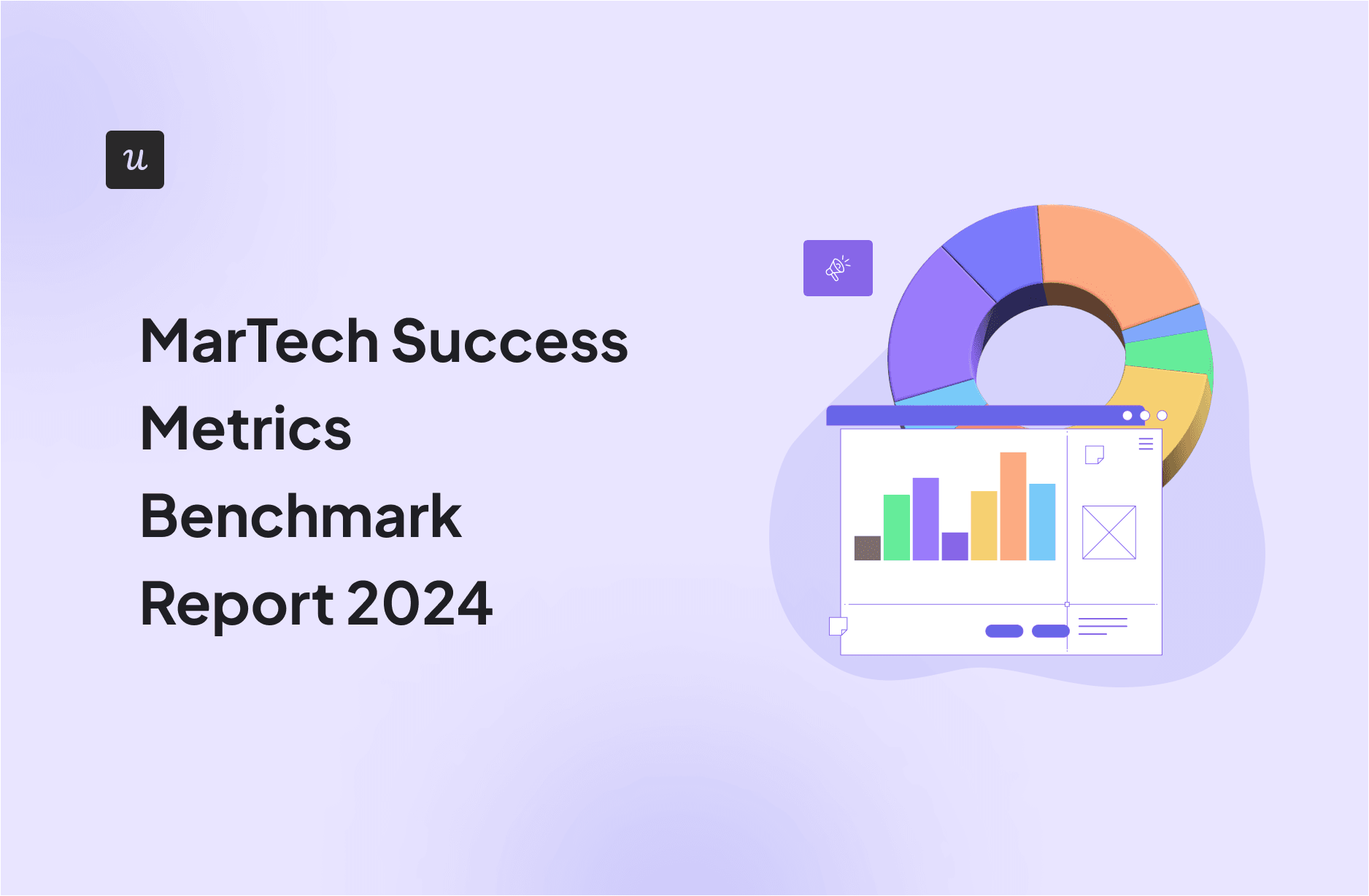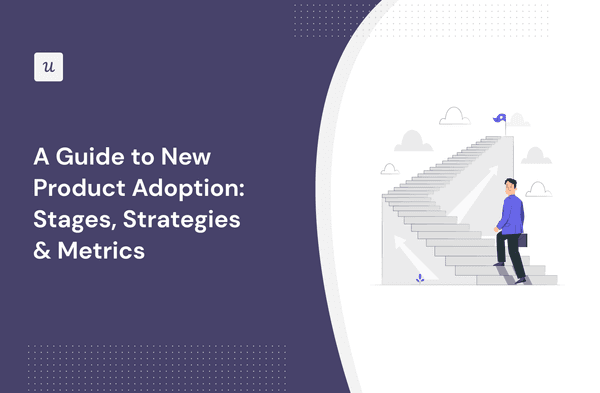
MarTech companies had the lowest onboarding c completion rates of all the industries we studied for our SaaS Product Metrics Benchmark Report.
Does it have any impact on new user activation, time-to-value, or other metrics?
That’s what we explore in the article. We also show you how you can improve the key success metrics for your MarTech SaaS.

Try Userpilot Now
See Why 1,000+ Teams Choose Userpilot

MarTech success metrics benchmark report – summary
- Userpilot’s SaaS Product Metrics Benchmark Report looks into 6 key product metrics data from 547 companies across 7+ verticals. Including MarTech.
Key findings from the report about MarTech companies include:
- Average customer activation rate: 24%.
- Time-to-value (TTV): 1 day, 20 hours, and 47 minutes
- Onboarding checklist completion rate: 12.5%
- Month 1 retention rate: 44.7%
- Net Promoter Score (NPS): 41
- If you could do one thing to improve the metrics, it would be designing personalized onboarding experiences that lead users to value along the most direct routes. So that new sign-ups can start using your product to solve their problems as quickly as possible.
- Want to see how Userpilot can help with that? Book the demo!
What is the MarTech success metrics benchmark report 2024
We’ve just released our SaaS Product Metrics Benchmark Report, in which we explore the data from SaaS companies across 7+ industries. Including 34 MarTech businesses.
To be more specific, we look into 6 metrics:
- New user activation rate.
- Onboarding checklist completion rate.
- Time to Value.
- 1 Month Retention Rate.
- Net Promoter Score.
- Core Feature Adoption Rate.
Average customer activation rate
User activation rate is the percentage of users who reach the activation milestone. In other words, start experiencing the product value.
The average activation rate for MarTech businesses was 24%, which puts them somewhere in the middle of the range. The overall average was 37.5%. The best-performing companies (AI & ML) had an average activation rate of 54.8%, while the worst-performing ones (FinTech & Insurance) – 5%.

What could be the reason for the below-average results?
The MarTech sector is highly saturated and lots of tools solve similar user problems. To make informed decisions, users take advantage of free trials and freemium plans but don’t necessarily commit to the tools 100%.
How to improve activation rate in MarTech products
Improving the new user activation rate by 25% can lead to a 34% increase in MRR, so it’s one of the key metrics to work on.
How to do it?
We’ve asked Yakov Carno, a PLG Adviser and Founder at Valubyl.
In his opinion, you first need to understand why new users sign up for your product: what problems they want to solve or what needs to be satisfied.
For example, users signing up for an email tool like MailChimp or ActiveCampaign may want to automate their drip campaigns to save time and minimize errors.
Next, you need to figure out the best way for them to achieve this.
You can do it by analyzing the in-app behavior of your power users. Paths, funnels, and session replay analysis can show you what exactly they do to realize product value.
Finally, design onboarding experiences that usher new users along their happy paths to activation.

Average time-to-value
Time-to-value (TTV) is closely related to user activation: it’s the time users need to reach the activation stage. Shorter TTV indicates that the product is user-friendly and intuitive, and offers excellent onboarding.
MarTech companies had an average TTV of 1 day, 20 hours, and 47 minutes. Which is over 8 hours longer than the average, and the second longest time overall.
The reason?
MarTech tools often require integration with other tools and databases before you can start reaping their benefits. Set up, data mapping, testing. All this takes time.
Moreover, their value often lies not in the basic features but in more advanced functionality. Which takes longer to activate.

How to improve time-to-value in MarTech products
The longer it takes for users to activate, the higher the risk they drop off. So it’s in your interest to reduce it as much as possible.
How?
The key term here is personalization.
When onboarding your customers, you don’t want them to learn about ALL the features. It’s unnecessary and can be overwhelming.
Instead, tailor the onboarding flows to their individual use cases. For example, if a social media management tool user is interested in orchestrating Facebook campaigns, don’t teach them how to integrate their LinkedIn accounts.
When ready, keep monitoring the flow performance to further optimize it. For example, use funnel and path analysis to find friction that could be slowing new users down.
Average onboarding checklist completion rate
Checklists are the knees bees in the onboarding toolkit. When designed well, they guide users through the tasks they need to activate. And motivate them to carry on until all are complete.
MarTech tools had the lowest checklist completion rate of all product categories in our report: 12.5%. The overall average was 19.2% while FinTech & Insurance companies had 24.5%.

The reason?
As mentioned, these tools tend to have intuitive UI and offer features similar to other products. This means users may feel tempted to skip the onboarding and dive right in. To start realizing the product value right away.
The initial impression seems to be misleading though. As we’ve seen from the TTV data, MarTech customers take longer to activate. Possibly, as a result of skipping the checklists.
How to improve onboarding checklist completion rate in MarTech products
There are a couple of things you can do to increase the completion rate.
First, decide what tasks to include in the checklist.
How?
Yoel Eilat, a Growth and Product Advisor, recommends analyzing feature usage patterns to identify those whose usage is closely correlated with user stickiness:
An approach I recommend is to examine the overlap between core user activities and the frequency of their return to the product (e.g. logging in for another session, using the feature again). Actions with a large intersection (i.e. correlation) are prime candidates for increasing user activation through checklists.

To make your checklists more compelling, add a progress bar and include a task that users complete before triggering the checklist, like setting up the account.
Both of these increase the user’s sense of achievement and motivate them to carry on.
Month 1 retention rate
Month 1 retention rate is the percentage of new users returning to use the product after the first month. It demonstrates that users find the product valuable early on, and it’s a good indicator of longer-term retention and customer lifetime value.
The MarTech companies we studied for the report had a Month 1 retention rate of 44.7%. Which was close to the overall average (46.9%) but considerably lower than in Fintech & Insurance companies (57.2%).
This could be due to the high competition in the MarTech sector. To find the tool they settle on, customers often sign up for multiple free trials and freemium plans.

How to improve month 1 retention rate in MarTech products
To improve Month 1 retention rate, focus on fully activating the users and reducing TTV. So personalized onboarding is again the key to success.
But it takes more to retain customers.
No matter how good your onboarding is, users will always find problems, so be sure to provide excellent customer support. Both low- and high-touch so that users can solve simple challenges independently while still having the option to fall back on the support agents if things get complicated.
Finally, offer incentives for users to keep coming back. Add gamification to the user journey or set up a loyalty program.
Average NPS
Net Promoter Score, or the NPS for mates, is a measure of customer satisfaction and loyalty. The higher the score, the more likely your customers are to recommend the product to their friends.
MarTech companies had an average NPS of 41. Which is above the overall average of 35.7%, and the second-highest score in our study (after Edtech with 47.5%).

How to improve NPS in MarTech products
The first step to improving NPS is ensuring the product solves genuine user problems. Tick?
If so, make sure users can experience the product value, so again, robust onboarding is a must. Ready?
Increase your customer satisfaction further by optimizing the user experience. Sort out all usability issues and bugs that could be causing friction.
While doing all this, figure out how to increase response rates. The more users take part in the NPS surveys, the more valid the results. For example, use analytics to find the best time to send the surveys.

Conclusion
Success metrics benchmarks indicate that increasing user activation, reducing TTV, and improving onboarding checklist completion rates are the main challenges for MarTech companies.
If that’s the case in your company and would like to learn how Userpilot can help, book the demo!







